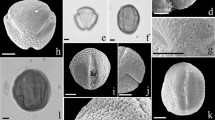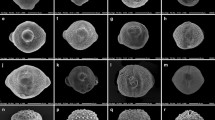Abstract
The pollen morphology of subtribe Menthinae sensu Harley et al. [In: The families and genera of vascular plants VII. Flowering plants·dicotyledons: Lamiales (except Acanthaceae including Avicenniaceae). Springer, Berlin, pp 167–275, 2004] and two genera of uncertain subtribal affinities (Heterolamium and Melissa) are documented in order to complete our palynological overview of the tribe Mentheae. Menthinae pollen is small to medium in size (13–43 μm), oblate to prolate in shape and mostly hexacolpate (sometimes pentacolpate). Perforate, microreticulate or bireticulate exine ornamentation types were observed. The exine ornamentation of Menthinae is systematically highly informative particularly at generic level. The exine stratification in all taxa studied is characterized by unbranched columellae. Orbicules are consistently absent in Menthinae. Our palynological data are interpreted in a phylogenetic context at tribal level in order to assess the systematic value of pollen characters and to evaluate the existing molecular phylogenies for this group. Pollen morphology suggests Heterolamium as a close relative of subtribe Nepetinae and supports the molecular affinity of Melissa to subtribe Salviinae.





Similar content being viewed by others
References
Abu-Asab MS, Cantino PD (1992) Pollen morphology in subfamily Lamioideae (Labiatae) and its phylogenetic implications. In: Harley RM, Reynolds T (eds) Advances in Labiatae science. Royal Botanic Gardens, Kew, pp 97–112
Abu-Asab MS, Cantino PD (1993) Systematic implications of pollen morphology in Caryopteris (Labiatae). Syst Bot 18:502–515
Abu-Asab MS, Cantino PD (1994) Systematic implications of pollen morphology in subfamilies Lamioideae and Pogostemonoideae (Labiatae). Ann Missouri Bot Gard 81:653–686
Afzal-Rafii Z (1983) Les pollens du genre Salvia et leur évolution. Pollen & Spores 25:351–366
Bentham G (1876) Labiatae. In: Bentham G, Hooker JD (eds) Genera plantarum, vol 2. Reeve and Co, London, pp 1160–1196
Bräuchler C, Meimber H, Abele T, Heubl G (2005) Polyphyly of the genus Micromeria (Lamiaceae)—evidence from cpDNA sequence data. Taxon 54:639–650
Briquet J (1897) Labiatae. In: Engler A, Prantl K (eds) Die naturlichen Pflanzenfamilien nebst ihrer Gattungen und wichtigeren Arten, vol IV. Wilhelm Engelmann, Leipzig, pp 183–287
Cantino PD (1992) Evidence for a polyphyletic origin of the Labiatae. Ann Missouri Bot Gard 79:361–379
Cantino PD, Harley RM, Wagstaff SJ (1992) Genera of Labiatae: status and classification. In: Harley RM, Reynolds T (eds) Advances in Labiatae science. Royal Botanic Gardens, Kew, pp 511–522
Dajoz I, Mignot A, Hoss C, Till-Bottraud I (1995) Pollen aperture heteromorphism is not due to unreduced gametophytes. Amer J Bot 82:104–111
Demissew S, Harley MM (1992) Trichome, seed surface and pollen charaters in Stachys (Labiatae) in Tropical Africa. In: Harley RM, Reynolds T (eds) Advances in Labiatae science. Royal Botanic Gardens, Kew, pp 149–166
Epling C (1948) A synopsis of the tribe Lepechinieae (Labiatae). Brittonia 6:352–364
Erdtman G (1945) Pollen morphology and plant taxonomy. IV. Labiatae, Verbenaceae and Avicenniaceae. Svensk Bot Tidskr 39:279–285
Erdtman G (1960) The acetolysis method. A revised description. Svensk Bot Tidskr 54:561–564
Furness CA, Rudall PJ (1998) The tapetum and systematics in monocotyledons. Bot Rev 64:201–239
Furness CA, Rudall PJ (2004) Pollen aperture evolution—a crucial factor for eudicot success? Trends Pl Sci 9:154–158
Harley MM (1992) The potential value of pollen morphology as an additional taxonomic character in subtribe Ociminae (Ocimeae: Nepetoidaea: Labiatae). In: Harley RM, Reynolds T (eds) Advances in Labiatae science. Royal Botanic Gardens, Kew, pp 125–138
Harley MM, Paton A, Harley RM, Cade PG (1992) Pollen morphological studies in tribe Ocimeae (Nepetoidaea: Labiatae): I. Ocimum L. Grana 31:161–176
Harley RM, Atkins S, Budantsev AL, Cantino PD, Conn BJ, Grayer R, Harley MM, De Kok R, Krestovskaja T, Morales R, Paton AJ, Ryding O, Upson T (2004) Labiatae. In: Kadereit JW (ed) The families and genera of vascular plants VII. Flowering plants·dicotyledons: Lamiales (except Acanthaceae including Avicenniaceae). Springer, Berlin, pp 167–275
Henderson DM, Prentice H, Hedge IC (1968) Pollen morphology of Salvia and some related genera. Grana Palynol 8:70–85
Holmgren PK, Holmgren NH, Barnett LC (1990) Index herbariorum, part 1. The herbaria of the world, vol 120, 8th edn. Regnum Veg. New York Botanical Garden, Bronx, pp 1–693
Huysmans S, El-Ghazaly G, Smets E (1998) Orbicules in angiosperms: morphology, function, distribution, and relation with tapetum types. Bot Rev 64:240–272
Huysmans S, El-Ghazaly G, Smets E (2000) Orbicules: still a well hidden secret of the anther. In: Nordenstam B, El-Ghazaly G, Kassas M (eds) Plant systematics for the 21st century. Wenner-Gren International Series, vol 77. Portland Press, London, pp 201–212
Jamzad Z, Harley MM, Ingrouille M, Simmonds MSJ, Jalili A (2000) Pollen exine and nutlet surface morphology of the annual species of Nepeta L. (Lamiaceae) in Iran. In: Harley MM, Morton GM, Blackmore S (eds) Pollen and spores: morphology and biology. Royal Botanic Gardens, Kew, pp 385–397
Jamzad Z, Chase MW, Ingrouille M, Simmonds MSJ, Jalili A (2003) Phylogenetic relatioships in Nepeta L. (Lamiaceae) and related genera based on ITS sequence data. Taxon 52:21–32
Lens F, Dressler S, Vinckier S, Janssens S, Dessein S, Van Evelghem L, Smets E (2005) Palynological variation in Balsaminoid Ericales. I. Marcgraviaceae. Ann Bot 96:1047–1060
Li X, Hedge IC (1994) Heterolamium. In: Wu ZY, Raven PH (eds) Flora of China, vol 17. Science Press/Missouri Botanical Garden, Beijing/St Louis, pp 294–295
Mignot A, Hoss C, Dajoz I, Leuret C, Henry JP, Druillaux JM, Heberle-Bors E, Till-Bottraud I (1994) Pollen aperture polymorphism in the angiosperms; importance, possible causes and consequences. Acta Bot Gall 141:109–122
Moon HK, Hong SP (2003) Pollen morphology of the genus Lycopus (Lamiaceae). Ann Bot Fenn 40:191–198
Moon HK, Vinckier S, Walker JB, Smets E, Huysmans S (2008a) A search for phylogenetically informative pollen characters in the subtribe Salviinae (Mentheae: Lamiaceae). Int J Pl Sci 169:455–471
Moon HK, Vinckier S, Smets E, Huysmans S (2008b) Comparative pollen morphology and ultrastructure of Mentheae subtribe Nepetinae (Lamiaceae). Rev Palaeobot Palynol 149:174–198. doi:10.1016/j.revpalbo.2007.12.001
Nabli MA (1976) Etude ultrastructurale comparee de l’exine chez quelques genres de Labiatae. In: Ferguson IK, Muller J (eds) The evolutionary significance of the exine. Academy Press, London, pp 499–525
Prather LA, Monfils AK, Posto AL, Williams RA (2002) Monophyly and phylogeny of Monarda (Lamiaceae): evidence from the internal transcribed spacer (ITS) regions of nuclear ribosomal DNA. Syst Bot 27:127–137
Punt W, Hoen PP, Blackmore S, Nilsson S, Le Thomas A (2007) Glossary of pollen and spore terminology. Rev Palaeobot Palynol 143:1–81
Raj B, El-Ghazaly G (1987) Morphology and taxonomic application of orbicules (Ubisch bodies) in Chloanthaceae. Pollen & Spores 29:151–166
Reitsma T (1969) Size modifications of recent pollen under treatments. Rev Palaeobot Palynol 9:175–202
Rudall P (1980) Pollen morphology in the subtribe Hyptidinae (Labiatae). Kew Bull 35:453–458
Schols P, Dessein S, D’Hondt C, Huysmans S, Smets E (2002) Carnoy: a new digital measurement tool for palynology. Grana 41:124–126
Schols P, Es K, D’hondt C, Merchx V, Smets E, Huysmans S (2004) A new enzyme-based method for the treatment of fragile pollen grains collected from herbarium material. Taxon 53:777–782
Suarez-Cervera M, Seoane-Camba JA (1986) Ontogénèse des grains de pollen de Lavandula dentata L. et évolution des cellules tapétales. Pollen & Spores 28:5–28
Trudel MC, Morton JK (1992) Pollen morphology and taxonomy in North American Labiatae. Canad J Bot 70:975–995
Trusty JL, Olmstead RG, Bogler DJ, Guerra AS, Francisco-Ortega J (2004) Using molecular data to test a biogeogrphic connection of the macaronesian genus Bystropogon (Lamiaceae) to the New World: a case of conflicting phylogenies. Syst Bot 29:702–715
Varghese TM, Verma DPS (1968) Pollen morphology of some Indian Labiatae. J Palynol 4:77–83
Vij SP, Kashyap SK (1975) Pollen grain studies in some Labiatae. J Palynol 11:29–42
Vinckier S, Smets E (2002) Morphology, ultrastructure and typology of orbicules in Loganiaceae s.l. and related genera, in relation to systematics. Rev Palaeobot Palynol 119:161–189
Wagstaff SJ (1992) A phylogenetic interpretation of pollen morphology in tribe Mentheae (Labiatae). In: Harley RM, Reynolds T (eds) Advances in Labiatae Science. Royal Botanic Gardens, Kew, pp 113–124
Wagstaff SJ, Olmstead RG, Cantino PD (1995) Parsimony analysis of cpDNA restriction site variation in subfamily Nepetoideae (Labiatae). Amer J Bot 82:886–892
Walker JW, Doyle JA (1975) The bases of angiosperm phylogeny: palynology. Ann Missouri Bot Gard 62:664–723
Walker JB, Sytsma KJ (2007) Staminal evolution in the genus Salvia (Lamiaceae): molecular phylogenetic evidence for multiple origins of the staminal lever. Ann Bot 100:375–391
Walker JB, Sytsma KJ, Treutlein J, Wink M (2004) Salvia (Lamiaceae) is not monophyletic: implications for the systematics, radiation, and ecological specializations of Salvia and tribe Mentheae. Amer J Bot 91:1115–1125
Waterman AH (1960) Pollen grain studies of the Labiatae in Michigan. Webbia 15:399–415
Wunderlich R (1967) Ein Vorschlag zu einer natürlichen Gliederung der Labiaten auf Grund der Pollenkörner, der Samenentwicklung und des reifen Samens. Oesterr Bot Z 114:383–483
Acknowledgments
We thank the directors of the herbaria of BR, G, GH, K, LV, MO and S for permitting the examination of specimens, either through loans or during visits. Sincere thanks also to two anonymous reviewers for their critical reading of manuscript and helpful suggestions. We are also grateful to Anja Vandeperre (K.U.Leuven) and An Vandoren (TEM, K.U.Leuven) for technical assistance. H.K. Moon thanks Dr. Alan Paton (Royal Botanic Gardens, Kew) for valuable discussions and Dr. Frederic Lens (K.U.Leuven) for helpful comments that improved this manuscript. A personal research grant of the K.U.Leuven (DB/06/054) was awarded to H.K. Moon. The Fund for Scientific Research-Flanders (FWO, G.0268.04 and G.0250.05) and the K.U.Leuven (OT/05/35) financially supported this research. S. Vinckier was a postdoctoral fellow of the Fund for Scientific Research-Flanders (FWO) during the course of this study.
Author information
Authors and Affiliations
Corresponding author
Appendix
Appendix
Table 3
Rights and permissions
About this article
Cite this article
Moon, HK., Vinckier, S., Smets, E. et al. Palynological evolutionary trends within the tribe Mentheae with special emphasis on subtribe Menthinae (Nepetoideae: Lamiaceae). Plant Syst Evol 275, 93–108 (2008). https://doi.org/10.1007/s00606-008-0042-y
Received:
Accepted:
Published:
Issue Date:
DOI: https://doi.org/10.1007/s00606-008-0042-y




